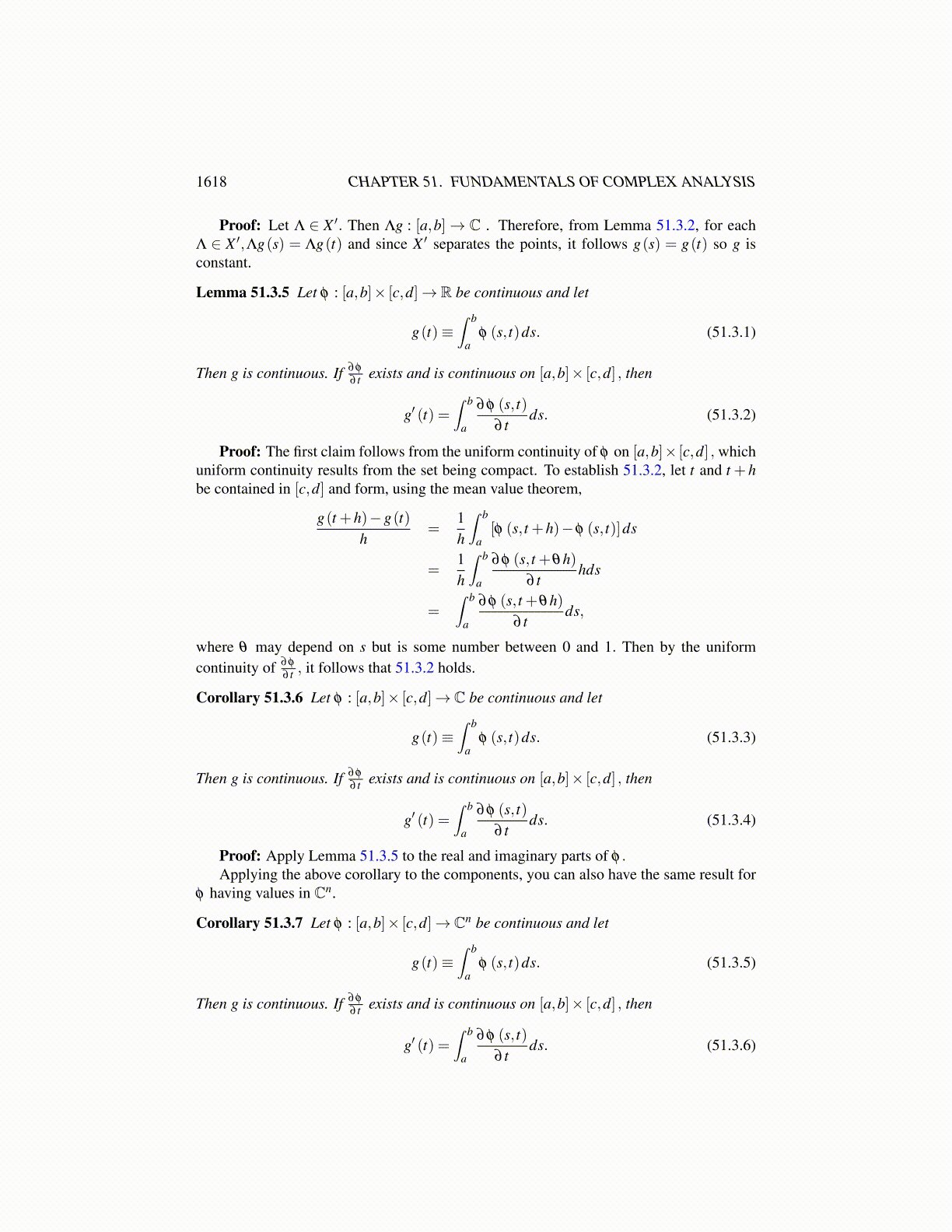
1618 CHAPTER 51. FUNDAMENTALS OF COMPLEX ANALYSIS
3. Let f : U → C be analytic and f (z) = u(x,y)+ iv(x,y) . Show u,v and uv are allharmonic although it can happen that u2 is not. Recall that a function, w is harmonicif wxx +wyy = 0.
4. Define a function f (z)≡ z≡ x− iy where z = x+ iy. Is f analytic?
5. If f (z) = u(x,y)+ iv(x,y) and f is analytic, verify that
det(
ux uyvx vy
)=∣∣ f ′ (z)∣∣2 .
6. Show that if u(x,y)+ iv(x,y) = f (z) is analytic, then ∇u ·∇v = 0. Recall
∇u(x,y) = ⟨ux (x,y) ,uy (x,y)⟩.
7. Show that every polynomial is analytic.
8. If γ (t) = x(t) + iy(t) is a C1 curve having values in U, an open set of C, and iff : U → C is analytic, we can consider f ◦ γ, another C1 curve having values inC. Also, γ ′ (t) and ( f ◦ γ)′ (t) are complex numbers so these can be considered asvectors in R2 as follows. The complex number, x+ iy corresponds to the vector,⟨x,y⟩. Suppose that γ and η are two such C1 curves having values in U and thatγ (t0) = η (s0) = z and suppose that f : U → C is analytic. Show that the anglebetween ( f ◦ γ)′ (t0) and ( f ◦η)′ (s0) is the same as the angle between γ ′ (t0) andη ′ (s0) assuming that f ′ (z) ̸= 0. Thus analytic mappings preserve angles at pointswhere the derivative is nonzero. Such mappings are called isogonal. . Hint: Tomake this easy to show, first observe that ⟨x,y⟩ · ⟨a,b⟩= 1
2 (zw+ zw) where z = x+ iyand w = a+ ib.
9. Analytic functions are even better than what is described in Problem 8. In addi-tion to preserving angles, they also preserve orientation. To verify this show thatif z = x+ iy and w = a+ ib are two complex numbers, then ⟨x,y,0⟩ and ⟨a,b,0⟩are two vectors in R3. Recall that the cross product, ⟨x,y,0⟩ × ⟨a,b,0⟩, yields avector normal to the two given vectors such that the triple, ⟨x,y,0⟩,⟨a,b,0⟩, and⟨x,y,0⟩×⟨a,b,0⟩ satisfies the right hand rule and has magnitude equal to the productof the sine of the included angle times the product of the two norms of the vectors.In this case, the cross product either points in the direction of the positive z axis orin the direction of the negative z axis. Thus, either the vectors ⟨x,y,0⟩,⟨a,b,0⟩,kform a right handed system or the vectors ⟨a,b,0⟩,⟨x,y,0⟩,k form a right handedsystem. These are the two possible orientations. Show that in the situation of Prob-lem 8 the orientation of γ ′ (t0) ,η ′ (s0) ,k is the same as the orientation of the vectors( f ◦ γ)′ (t0) ,( f ◦η)′ (s0) ,k. Such mappings are called conformal. If f is analyticand f ′ (z) ̸= 0, then we know from this problem and the above that f is a con-formal map. Hint: You can do this by verifying that ( f ◦ γ)′ (t0)× ( f ◦η)′ (s0) =
| f ′ (γ (t0))|2 γ ′ (t0)×η ′ (s0). To make the verification easier, you might first estab-lish the following simple formula for the cross product where here x+ iy = z anda+ ib = w.
(x,y,0)× (a,b,0) = Re(ziw)k.